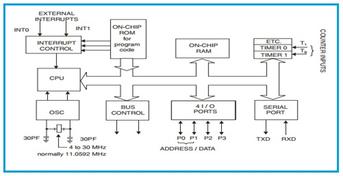8051 Instruction Set: Opcode, Operand, Size, and M-Cycle
Comprehensive guide to the 8051 instruction set, including opcode, operand, size, and machine cycle details for each instruction.
Showing 20 posts (Page 1 of 3)
Advertisement
Comprehensive guide to the 8051 instruction set, including opcode, operand, size, and machine cycle details for each instruction.

Explore the pros and cons of the 8051 microcontroller, covering its features, benefits, limitations, and applications in embedded systems.

Explore the IE (Interrupt Enable) and IP (Interrupt Priority) registers in the 8051 microcontroller for managing and prioritizing interrupts effectively.

Explore the core differences between the 8051 microcontroller and the 8085 microprocessor, including architecture, memory, features, and applications.

Explore the pros and cons of using the 8251 USART chip in communication systems, including its versatility, limitations, and applications.
Prepare for your Arduino Uno job interview or engineering viva with these 10 frequently asked questions and detailed answers.
Explore the distinctions between Arduino Uno and Leonardo, focusing on microcontrollers, detachability, and pin configurations. Discover which board suits your project needs.

Explore the differences between Arduino and Raspberry Pi, covering their functionality, specifications, and ideal use cases.
Explore the key differences between ARM Cortex-M, Cortex-A, and Cortex-R processors, focusing on their applications, performance, and features.

A comparison of ARM Cortex-M0, M3, and M4 microcontrollers, highlighting their key features, performance, and target applications to aid in selecting the right core.

A comparison of ARM Cortex-R4, R5, and R7 processors, highlighting their key features, performance, error management, and target applications in embedded systems.

Explore the ATmega328 microcontroller's features, pinout, benefits, and applications. Discover its architecture, memory, peripherals, and uses in embedded systems.
Atmel Corporation ships its new Atmel® SAM D20 microcontrollers. This is the first series in a new family of ultra-low power embedded Flash microcontrollers based on the ARM® Cortex®-M0+ processor.

Explore Digital Signal Controllers (DSCs), specialized microcontrollers combining MCU and DSP strengths for real-time control and high-speed signal processing across various applications.

Compare ESP32 and ESP8266 Wi-Fi boards. Explore features, similarities, and differences to help you choose the right one for your project.

Explore the ESP8266 WiFi module's features, pinout, and applications. Learn how this versatile module enables IoT projects with its built-in WiFi and microcontroller capabilities.

Explore the distinctions between FPGAs and microcontrollers, including functionality, flexibility, programming, cost, and applications, to choose the right one.
Freescale Semiconductor introduces the Kinetis E-series MCUs, 32-bit microcontrollers with ARM Cortex-M0+ core, designed for high performance and extended battery life in harsh environments.

Explore the Intel 8051 microcontroller architecture, covering its key components like CPU, memory, I/O ports, timers, serial communication, and interrupts. Learn about its practical applications.
Explore the ATMEL AVR series of microcontrollers, focusing on the AVR 8-bit and AVR 32-bit architectures, key features, and performance highlights.
Advertisement